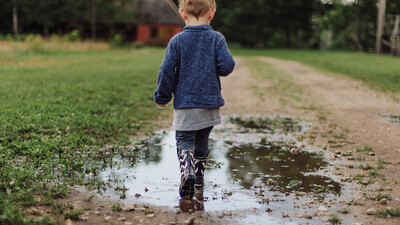What Is a French Drain?
A French drain is a simple, yet highly effective drainage solution designed to divert surface water and groundwater away from structures, gardens, or other vulnerable areas. It consists of a trench filled with gravel or aggregate, housing a perforated pipe that collects and redirects excess water.
Named after Henry Flagg French, an American lawyer and agriculturalist who popularised the concept in the 19th century, French drains are widely used in residential, commercial and agricultural settings to prevent waterlogging and structural damage.
Installing a French drain is a practical solution for managing excess water and preventing property damage. By understanding its function, design considerations and maintenance requirements, homeowners and contractors can ensure long-term drainage success.
How Do French Drains Work?
French drains operate by providing a path of least resistance for water to flow away from areas which tend to flood or become waterlogged.
When rainwater or groundwater infiltrates the soil, it seeps into the French drain’s gravel-filled trench and enters a perforated pipe. The pipe then channels the water away to a suitable drainage point, such as a soakaway, storm drain or natural watercourse. By promoting controlled water movement, French drains help mitigate issues such as foundation damage, basement flooding and soil erosion.
Where Can French Drains Be Used?
French drains are highly versatile and can be installed in various locations where excess water poses a risk. In residential settings, they are commonly used to protect basements, prevent water pooling in gardens and improve lawn drainage. They are also useful in commercial developments, particularly in areas with high water tables or poor soil drainage. Agricultural land can benefit from French drains by preventing waterlogging, which can otherwise hinder crop growth and affect soil health.
When Should French Drains Be Avoided?
Although French drains are effective in many scenarios, they are not suitable for every situation. They should not be used where the outflow of water could cause additional issues, such as near neighbouring properties or public infrastructure. Properties with clay-heavy soil may find French drains less effective, as the slow percolation rate of clay can limit water absorption into the drainage system. Additionally, areas subject to heavy vehicle traffic may require reinforced drainage solutions, as French drains can become compressed and less effective under excessive weight.
Designing a French Drain System
Proper design is crucial to ensuring a French drain functions effectively. One of the key considerations is the layout pattern, which determines how efficiently water is collected and redirected.
French Drain: Linear or Herringbone?
The two most common configurations are the linear pattern and the herringbone pattern.
A linear French drain runs in a straight line from the problem area to an appropriate drainage outlet, making it ideal for directing water away from a single source, such as a building foundation or a low-lying garden.
The herringbone pattern, on the other hand, consists of multiple branches feeding into a central drainage line, making it more suitable for large areas where water must be collected evenly from different directions.
The Gradient
Another design factor is the gradient of the system. To ensure proper water flow, the trench should have a consistent slope of at least 1%, meaning it should drop by at least 1cm per metre. Insufficient slope can result in water pooling within the pipe, reducing the system's effectiveness.
The Trench
The depth and width of the trench will depend on the expected volume of water and the type of soil. In well-draining soils, a trench depth of around 450-600mm is generally sufficient, whereas poorly draining soils may require deeper excavation. The choice of pipe is equally important, with perforated plastic pipes being a common choice due to their durability and efficiency. Additionally, the gravel size should be carefully selected to prevent clogging while allowing for adequate water flow.
The Outflow
Finally, it is crucial to consider the location of the outflow. The drain must lead to an appropriate discharge point, such as a soakaway, a storm drain, or an area where water can safely disperse without causing erosion or structural damage to property. When designing a system, it is also advisable to include inspection points or access ports to facilitate future maintenance and troubleshooting.
How to Install a French Drain
Installing a French drain involves several key steps:
Excavate the Trench
Dig a trench along the desired drainage path, ensuring a consistent slope of at least 1% to allow water to flow away naturally.
Lay a Geotextile Fabric
Line the trench with a permeable geotextile fabric to prevent soil and debris from clogging the system.
Add a Gravel Base
Place a layer of coarse gravel or aggregate at the bottom of the trench.
Position the Perforated Pipe
Lay the pipe with the perforations facing downwards to encourage water collection.
Fill with Gravel
Cover the pipe with additional gravel, leaving space for soil or turf at the surface.
Fold Over the Geotextile
Wrap the fabric over the gravel layer to minimise sediment infiltration.
Backfill the Trench
Cover the system with soil or decorative aggregate, depending on the intended aesthetic.
Maintaining a French Drain
Regular maintenance ensures that a French drain continues to function effectively. Over time, debris, silt and organic matter can accumulate within the gravel or pipe, reducing drainage efficiency. Inspecting the system annually and flushing the pipe with water if blockages occur can help maintain optimal performance. Keeping surface drains clear of leaves and other debris is also important, as this helps prevent excess material from entering the system.
Troubleshooting Common French Drain Issues
Even well-designed French drains can experience problems. A common issue is slow drainage, often caused by soil clogging the pipe perforations or insufficient slope in the system. In such cases, flushing the pipe with high-pressure water or replacing the gravel may help. If the drain stops functioning altogether, excavation and pipe replacement might be necessary. Poor installation, such as incorrect pipe orientation or inadequate slope, can also lead to inefficiencies and may require professional intervention.
French Drain FAQs
How long does a French drain last?
A properly installed French drain can last for several decades with minimal maintenance. The longevity depends on factors such as soil conditions, pipe material, and the presence of root intrusion.
Can a French drain be installed indoors?
Yes, French drains can be installed inside properties, particularly in basements prone to flooding. These indoor systems typically channel water to a sump pump, which then redirects it away from the property.
Do French drains require planning permission?
In most cases, planning permission is not required for a French drain installed on private property. However, if the drainage system affects public land or a neighbouring property, consultation with local authorities may be necessary.
Can a French drain handle heavy rainfall?
French drains are effective at managing moderate to heavy rainfall, but their capacity depends on the design and installation quality. For areas with extreme weather conditions, additional drainage solutions, such as stormwater management systems, may be required.
Drainfast – The Drainage Experts
This information is brought to you by Drainfast, one of the UK’s largest independent drainage products suppliers. If you’re considering installing a French drain, give our experts a call for friendly, impartial advice and a wide range of products in stock for immediate despatch across the UK. If you decide to use a contractor, ask if they are using Drainfast!

Written by
Bob Stone
Technical Sales
Heading up our Technical Estimating Department, Bob is our in-house quantity surveyor.

